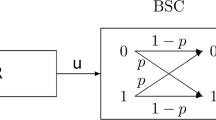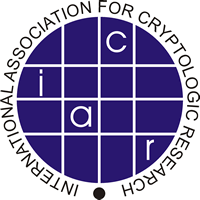Abstract
In this paper, a method for searching correlations between the binary stream of Linear Feedback Shift Register (LFSR) and the keystream of SNOW-V and SNOW-Vi is presented based on the technique of approximation to composite functions. With the aid of the linear relationship between the four taps of LFSR input into Finite State Machine (FSM) at three consecutive clocks, we present an automatic search model based on the SAT/SMT technique and search out a series of linear approximation trails with high correlation. By exhausting the intermediate masks, we find a binary linear approximation with a correlation \(-2^{-47.76}\). Using such approximation, we propose a correlation attack on SNOW-V with an expected time complexity \(2^{246.53}\), a memory complexity \(2^{238.77}\) and \(2^{237.5}\) keystream words generated by the same key and Initial Vector (IV). For SNOW-Vi, we provide a binary linear approximation with the same correlation and mount a correlation attack with the same complexity as that of SNOW-V. To the best of our knowledge, this is the first known attack on full SNOW-V and SNOW-Vi, which is better than the exhaustive key search with respect to time complexity. The results indicate that neither SNOW-V nor SNOW-Vi can guarantee the 256-bit security level if we ignore the design constraint that the maximum length of keystream for a single pair of key and IV is less than \(2^{64}\).
Access this chapter
Tax calculation will be finalised at checkout
Purchases are for personal use only
Similar content being viewed by others
References
Ekdahl, P., Johansson, T.: SNOW - a new stream cipher. In: Proceedings of First Open NESSIE Workshop, KU-Leuven, pp. 167–168 (2000)
Ekdahl, P., Johansson, T.: A new version of the stream cipher SNOW. In: Nyberg, K., Heys, H. (eds.) SAC 2002. LNCS, vol. 2595, pp. 47–61. Springer, Heidelberg (2003). https://doi.org/10.1007/3-540-36492-7_5
ETSI/SAGE.: Specification of the 3GPP confidentiality and integrity algorithms UEA2 & UIA2 (2006)
Ekdahl, P., Johansson, T., Maximov, A., Yang, J.: A new SNOW stream cipher called SNOW-V. IACR Trans. Symmetric Cryptol. 2019(3), 1–42 (2019)
Ekdahl, P., Maximov, A., Johansson, T., Yang, J.: SNOW-Vi: an extreme performance variant of SNOW-V for lower grade CPUs. In: Pöpper, C., Vanhoef, M., Batina, L., Mayrhofer, R. (eds.) WiSec 2021, pp. 261–272. ACM, New York (2021)
Cid, C., Dodd, M., Murphy, S.: A security evaluation of the SNOW-V stream cipher. Quaternion Security Ltd, 4 June 2020. https://www.3gpp.org/ftp/tsg_sa/WG3_Security/TSGS3_101e/Docs/S3-202852.zip
Jiao, L., Li, Y., Hao, Y.: A guess-and-determine attack on SNOW-V stream cipher. Comput. J. 63(12), 1789–1812 (2020)
Gong, X., Zhang, B.: Resistance of SNOW-V against fast correlation attacks. IACR Trans. Symmetric Cryptol. 2021(1), 378–410 (2021)
Yang, J., Johansson, T., Maximov, A.: Improved guess-and-determine and distinguishing attacks on SNOW-V. IACR Trans. Symmetric Cryptol. 2021(3), 54–83 (2021)
Hoki, J., Isobe, T., Ito, R., Liu, F., Sakamoto, K.: Distinguishing and key recovery attacks on the reduced-round SNOW-V and SNOW-Vi. Cryptology ePrint Archive, Report 2021/546 (2021)
Shi, D., Sun, S., Sasaki, Yu., Li, C., Hu, L.: Correlation of quadratic boolean functions: cryptanalysis of all versions of full \(\sf MORUS\). In: Boldyreva, A., Micciancio, D. (eds.) CRYPTO 2019, Part II. LNCS, vol. 11693, pp. 180–209. Springer, Cham (2019). https://doi.org/10.1007/978-3-030-26951-7_7
Ganesh, V., Hansen, T., Soos, M., Liew, D., Govostes, R.: STP constraint solver (2014). https://github.com/stp/stp
Abdelkhalek, A., Sasaki, Y., Todo, Y., Tolba, M., Youssef, A.M.: MILP modeling for (large) S-boxes to optimize probability of differential characteristics. IACR Trans. Symmetric Cryptol. 2017(4), 99–129 (2017)
Liu, Yu., Liang, H., Li, M., Huang, L., Hu, K., Yang, C., Wang, M.: STP models of optimal differential and linear trail for S-box based ciphers. SCIENCE CHINA Inf. Sci. 64(5), 1–3 (2021). https://doi.org/10.1007/s11432-018-9772-0
Zhou, C., Feng, X., Wu, C.: Linear approximations of addition modulo \(2^{n}\). In: Joux, A. (ed.) FSE 2011. LNCS, vol. 6733, pp. 359–377. Springer, Heidelberg (2011). https://doi.org/10.1007/978-3-642-21702-9_21
Schulte-Geers, E.: On CCZ-equivalence of addition mod \(2^n\). Des. Codes Cryptogr. 66, 111–127 (2013)
Zhang, B., Xu, C., Meier, W.: Fast correlation attacks over extension fields, large-unit linear approximation and cryptanalysis of SNOW 2.0. In: Gennaro, R., Robshaw, M. (eds.) CRYPTO 2015. LNCS, vol. 9215, pp. 643–662. Springer, Heidelberg (2015). https://doi.org/10.1007/978-3-662-47989-6_31
Selçuk, A.A.: On probability of success in linear and differential cryptanalysis. J. Cryptol. 21(1), 131–147 (2008)
Blondeau, C., Gérard, B., Tillich, J.P.: Accurate estimates of the data complexity and success probability for various cryptanalyses. Des. Codes Cryptogr. 59, 3–34 (2011)
Acknowledgement
We thank the anonymous reviewers for their valuable suggestions on how to improve this paper. Also, we thank Alexander Maximov for helpful discussion and verification of our results. This work is supported by National Natural Science Foundation of China (Grant No. 61772547).
Author information
Authors and Affiliations
Corresponding author
Editor information
Editors and Affiliations
Appendices
A Detailed Reasoning Process of Intermediate Masks
Based on the linear approximation of F in Sect. 3, we analyze the intermediate masks in the case that the input and output masks are fixed as \((\gamma ,\beta ,l,m,n,\gamma )\) and \((\alpha ,\alpha ,h,\beta )\) respectively. We denote \(\xi _{j}^{i}\) the mask of the j-th output of \({{f}_{i}}\) and \({{\rho }_{i}}\) the correlation of \({{f}_{i}}\). Then the linear approximation equation of \({{f}_{1}}\) is
which is equivalent to
With the assumption that \({{\rho }_{1}}\ne 0\), we have \(\xi _{2}^{1}=\beta ,\xi _{6}^{1}=\gamma \). Denoting \(\xi _{1}^{1}=a,\xi _{3}^{1}=e,\xi _{4}^{1}=f,\xi _{5}^{1}=d\), we have \(d \mathbf {\boldsymbol{L}}=(e\oplus l)||(f\oplus m)\) by
and (3) is equivalent to \(\gamma \cdot x\overset{{{\rho }_{1}}}{\mathop {=}}\,a\cdot (x\boxminus v)\oplus (n\oplus d)\cdot v\), which is the linear approximation \(a,n\oplus d \rightarrow \gamma \) of the addition modulo \({{2}^{32}}\). Thus the correlation of (3) is \({{\rho }_{1}}={{\rho }_{A}}(a,n\oplus d \rightarrow \gamma )\).
For \({{f}_{2}}\), we have
which is equivalent to
By \({{\rho }_{2}}\ne 0\) we know that \(\xi _{3}^{2}=e,\xi _{4}^{2}=f,\xi _{6}^{2}=\gamma \), \(\xi _{1}^{2}=d\oplus \xi _{5}^{2}\). Denoting \(\xi _{2}^{2}=b\), then (4) is equivalent to \(\xi _{1}^{2}\cdot ({\boldsymbol{\sigma }^{-1}}(x)\boxminus y)\oplus a\cdot x\oplus (\beta \oplus \xi _{2}^{2})\cdot y=0\). Let \(X={\boldsymbol{\sigma }^{-1}}(x)\), then the above equation can be converted to
which is the linear approximation \(\beta \oplus b,d\oplus \xi _{5}^{2} \rightarrow a \boldsymbol{\sigma }\) of the addition modulo \({{2}^{32}}\), hence \({{\rho }_{2}}={{\rho }_{A}}(\beta \oplus b,d\oplus \xi _{5}^{2} \rightarrow {a{\mathbf {\boldsymbol{\sigma } }}})\).
For \({{f}_{3}}\), the following equation holds
It is equivalent to
By \({{\rho }_{3}}\ne 0\) we know that \(\xi _{3}^{3}=e,\xi _{4}^{3}=f,\xi _{5}^{3}=\xi _{5}^{2},\xi _{6}^{3}=\gamma \). Let \(\xi _{2}^{3}=c\), then (5) is equivalent to \([\xi _{1}^{3}\cdot {{E}^{-1}}(x)\oplus (d\oplus \xi _{5}^{2})\cdot x]\oplus [\xi _{2}^{3}\cdot {{E}^{-1}}(y)\oplus b\cdot y]\overset{{{\rho }_{3}}}{\mathop {=}}\,0\), which is the two linear approximations \(\xi _{1}^{3} \overset{AES}{\mathop {\rightarrow }}\,d\oplus \xi _{5}^{2}\) and \(c\overset{AES}{\mathop {\rightarrow }}\,b\) of AES round function, so we have \({{\rho }_{3}}={{\rho }_{E}}(\xi _{1}^{3} \rightarrow d\oplus \xi _{5}^{2}){{\rho }_{E}}(c\rightarrow b)\).
For \({{f}_{4}}\), we have
which is equivalent to
By \({{\rho }_{4}}\ne 0\) we know that \(\xi _{1}^{4}=\xi _{1}^{3},\xi _{3}^{4}=f,\xi _{4}^{4}=\xi _{5}^{2},\xi _{5}^{4}=\gamma \), and we can rewrite the above equation as \(\xi _{2}^{4}\cdot (y\boxplus z)\overset{{{\rho }_{4}}}{\mathop {=}}\,c\cdot y\oplus e\cdot z\), which is the approximation \(c,e \rightarrow \xi _{2}^{4}\) of addition modulo \(2^{32}\). Obviously \({{\rho }_{4}}={{\rho }_{A}}(c,e \rightarrow \xi _{2}^{4})\).
For \({{f}_{5}}\), the approximation equation is
which is equivalent to
By \({{\rho }_{5}}\ne 0\) we know that \(\xi _{1}^{5}=\xi _{1}^{3},\xi _{2}^{5}=\xi _{2}^{4},\xi _{3}^{5}=f,\xi _{4}^{5}=\xi _{5}^{2}\). Denoting \(\xi _{5}^{5}=q\), then (7) can be reduced to \(q\cdot {{E}^{-1}}(v)\oplus \gamma \cdot v\overset{{{\rho }_{5}}}{\mathop {=}}\,0\), which is the linear approximation \(q \overset{AES}{\mathop {\rightarrow }}\,\gamma \) of AES round function, so \({{\rho }_{5}}={{\rho }_{E}}(q \rightarrow \gamma )\).
For \({{f}_{6}}\), we have
By \({{\rho }_{6}}\ne 0\) we know that \(\xi _{1}^{3}=\xi _{2}^{4}=\alpha ,\xi _{5}^{2}=h\), and (8) can be simplified to \(\beta \cdot (z\boxplus v)\oplus f\cdot z\oplus q\cdot v\overset{{{\rho }_{6}}}{\mathop {=}}\,0\), which is the linear approximation \(f,q \rightarrow \beta \) of addition modulo \(2^{32}\). So we have \({{\rho }_{6}}={{\rho }_{A}}(f,q \rightarrow \beta )\).
Thus, the linear approximation trail of F can be described as
B The Proof of \(d=(\texttt {0},\texttt {0},\texttt {0},\texttt {0})\) Under \(d \mathbf {L} =(0x000000*,\texttt {0},\texttt {0},\texttt {0},0x000000*,\texttt {0},\texttt {0},\texttt {0})\)
Here we denote 128-bit vector \(d=(d_7, d_6,...,d_0)\) in which \(d_i \in GF(2^{16})\), and \(\mathbf {\boldsymbol{\beta }}\) the binary matrix form of \(\beta \in GF(2^{16})\). By the relation
we have
which is equivalent to
Recall
we can observe that
As \(\mathbf {\boldsymbol{\beta }}\) is invertible, we can get \(d=(\texttt {0},\texttt {0},\texttt {0},\texttt {0}).\)
Rights and permissions
Copyright information
© 2022 International Association for Cryptologic Research
About this paper
Cite this paper
Shi, Z., Jin, C., Zhang, J., Cui, T., Ding, L., Jin, Y. (2022). A Correlation Attack on Full SNOW-V and SNOW-Vi. In: Dunkelman, O., Dziembowski, S. (eds) Advances in Cryptology – EUROCRYPT 2022. EUROCRYPT 2022. Lecture Notes in Computer Science, vol 13277. Springer, Cham. https://doi.org/10.1007/978-3-031-07082-2_2
Download citation
DOI: https://doi.org/10.1007/978-3-031-07082-2_2
Published:
Publisher Name: Springer, Cham
Print ISBN: 978-3-031-07081-5
Online ISBN: 978-3-031-07082-2
eBook Packages: Computer ScienceComputer Science (R0)





